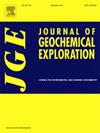湖北广水变质沉积岩型三稀土矿床成矿过程
IF 3.3
2区 地球科学
Q1 GEOCHEMISTRY & GEOPHYSICS
引用次数: 0
摘要
湖北广水是一个特殊的重稀土矿床,赋存于一系列变质沉积岩(如瘦斑岩)中。本研究结合详细的岩石学、原位U-Pb年代学、Nd同位素系统学和主要稀土相(钆长石、褐长石、单氮石和xenotime)的矿物化学,重建了成矿的时间、来源和机制。根据晶体习性和共生关系,每种矿物可分为两代:Gad-I/II、gs- i /II、Mnz-I/II、Xtm-I/II。Mnz-I的U-Pb年龄为239±13 Ma,而Xtm-I的年龄为210±6 Ma。这些年龄与大别造山带三叠纪高变质作用的进、退阶段相吻合,表明区域变质作用与三稀土元素活动有直接联系。岩石学观察表明,Mnz-I标志着最早的HREE组合结晶(fg - i + Gad-I),而Xtm-I则标志着HREE成矿的最后阶段。两代矿物之间的地球化学差异是明显的。Mnz-I和Mnz-II的Th含量较低,与热液成因一致。Mnz-II与Xtm-II存在空间关联,其明显的HREE富集与从Xtm-I到Xtm-II的HREE耗竭相吻合,表明Xtm-II是由Xtm-I的蚀变形成的。gs- 1和gad - 1的正Ce异常提示在氧化条件下结晶。结合岩石学证据和地球化学变化,认为Gad-II的组成可能受到同时期热液锆石结晶的影响。对于gs- ii,热液蚀变可能促进了LREE和Ca取代了a位的HREE和Y。Mnz-I的Nd同位素组成(εNd(t) =−5.1 ~−5.6;TDM2 = 1.38 - -1.43 Ga)和Mnz-II(εNd (t) =−4.8−5.8;TDM2 = 1.38 ~ 1.45 Ga)表明成矿物质可能来源于中元古代岩石。从区域上看,富磷黄麦岭组和三叠系变质作用对稀土元素富集起关键作用。综上所述,广水矿床是受大陆碰撞过程中变质作用和流-岩相互作用控制的稀土矿化矿床,其成矿作用与大别造山带三叠纪演化密切相关。本文章由计算机程序翻译,如有差异,请以英文原文为准。
Metallogenic process of the metasedimentary rock-hosted HREE deposit at Guangshui (Hubei Province, Central China)
Guangshui (Hubei Province, Central China) is an exceptional heavy rare earth element (HREE) deposit that occurred within a series of metasedimentary rock (e.g. leptynite). This study integrates detailed petrography with in situ U-Pb geochronology, Nd isotope systematics, and mineral chemistry of the principal REE phases—gadolinite, fergusonite, monazite and xenotime—to reconstruct the timing, sources and mechanisms of mineralization. Two generations of each mineral are recognized on the basis of crystal habit and paragenesis: Gad-I/II, Fgs-I/II, Mnz-I/II, Xtm-I/II. U-Pb dating of Mnz-I yields an age of 239 ± 13 Ma, while Xtm-I records 210 ± 6 Ma. These ages coincide with prograde and retrograde stages of Triassic high-grade metamorphism in the Dabie orogen, underscoring a direct link between regional metamorphism and HREE mobilization. Petrological observations indicate that the Mnz-I marks the crystallization of the earliest HREE assemblage (Fgs-I + Gad-I), whereas Xtm-I brackets the final stage of HREE mineralization. Geochemical variations between the two mineral generations are evident. Mnz-I and Mnz-II exhibit low Th contents, consistent with a hydrothermal origin. Mnz-II is spatially associated with Xtm-II, and its pronounced HREE enrichment coincides with HREE depletion from Xtm-I to Xtm-II, suggesting that Xtm-II formed via alteration of Xtm-I. Positive Ce anomalies in Fgs-I and Gad-I suggest crystallization under oxidizing conditions. Combined with petrological evidence and geochemical variation, the composition of Gad-II may have affected by coeval hydrothermal zircon crystallization. For Fgs-II, hydrothermal alteration likely facilitated substitution of LREE and Ca for HREE and Y at the A-site. Nd isotope compositions of Mnz-I (εNd(t) = −5.1 to −5.6; TDM2 = 1.38–1.43 Ga) and Mnz-II (εNd(t) = −4.8 to −5.8; TDM2 = 1.38–1.45 Ga) indicate a crustal source for the ore-forming materials, most likely derived from Mesoproterozoic rocks. Regionally, the phosphorus-rich Huangmailing Formation and Triassic metamorphism played critical roles in HREE enrichment. Overall, the Guangshui deposit exemplifies HREE mineralization controlled by metamorphism and fluid–rock interaction during continental collision, firmly tying its metallogenesis to the Triassic evolution of the Dabie orogen.
求助全文
通过发布文献求助,成功后即可免费获取论文全文。
去求助
来源期刊

Journal of Geochemical Exploration
地学-地球化学与地球物理
CiteScore
7.40
自引率
7.70%
发文量
148
审稿时长
8.1 months
期刊介绍:
Journal of Geochemical Exploration is mostly dedicated to publication of original studies in exploration and environmental geochemistry and related topics.
Contributions considered of prevalent interest for the journal include researches based on the application of innovative methods to:
define the genesis and the evolution of mineral deposits including transfer of elements in large-scale mineralized areas.
analyze complex systems at the boundaries between bio-geochemistry, metal transport and mineral accumulation.
evaluate effects of historical mining activities on the surface environment.
trace pollutant sources and define their fate and transport models in the near-surface and surface environments involving solid, fluid and aerial matrices.
assess and quantify natural and technogenic radioactivity in the environment.
determine geochemical anomalies and set baseline reference values using compositional data analysis, multivariate statistics and geo-spatial analysis.
assess the impacts of anthropogenic contamination on ecosystems and human health at local and regional scale to prioritize and classify risks through deterministic and stochastic approaches.
Papers dedicated to the presentation of newly developed methods in analytical geochemistry to be applied in the field or in laboratory are also within the topics of interest for the journal.
 求助内容:
求助内容: 应助结果提醒方式:
应助结果提醒方式:


